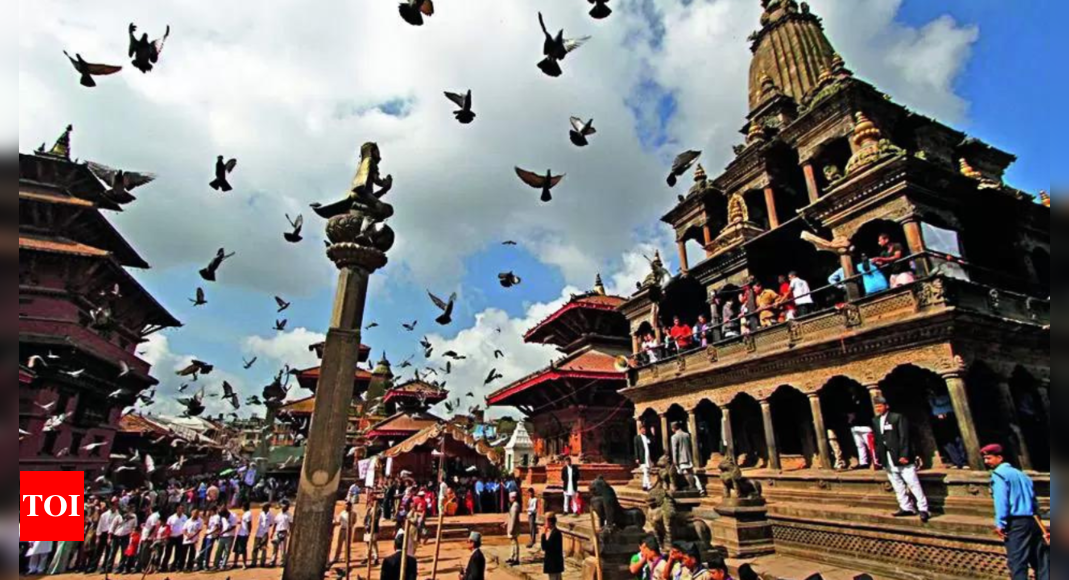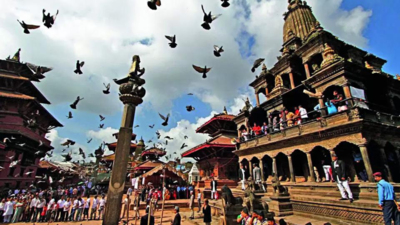KATHMANDU : The first bells of Navratri had barely quieted in the Taleju temple at Durbar Square when the whispers began: “Raja aaunparcha.” The king must return. Ramnavami is just days away, and the timing isn’t lost on anyone. It is a season that celebrates righteous kings. In Kathmandu’s streets and elsewhere, that possibility has engorged crowds that had not long ago abandoned their monarch, reports .
At a tea shop tucked into the narrow alleys behind Indra Chowk, a short walk away from the palace complex, Amrit Thapa (62) stirred his chai slowly, his eyes fixed on a raucous group of people just beyond the awning. “The politicians promised us a republic,” he said, “but all we got was chaos. We’ve run out of options. Only the king is left.” Thapa wasn’t being rhetorical. Across Kathmandu’s historic core – from Basantapur to the edges of Thamel – Nepal is witnessing its most sustained pro-monarchy protests since the royal family was swept aside in 2008.
Nepal downsizes ex-king’s security team
Thousands – by some estimates, lakhs – have filled the streets in recent days, waving national flags and calling for the return of the king, whose security has now been downsized.
The Armed Police Force (APF) has withdrawn 10 personnel from former king Gyanendra Shah’s security detail, reducing the team from 25 to 15. A senior APF official said, “There will be another decision in a few days.” The reduction is part of a broader govt move to scale back facilities extended to former heads of state. At its peak, 155 APF personnel had been deployed for the former royal family. Of these, 25 were assigned to Gyanendra alone. Security for other family members has also been withdrawn, with those personnel ordered to return to the APF task force within two days.
The administration has reason for rage. Though initial reports in the international media called the crowds “10,000-15,000 strong,” people scoffed at those numbers. “There were lakhs when Gyanendra came back last week,” said Ravi Tamang, a 25-year-old who runs a phone accessories stall just off Mandala Street. “And even more on Friday (March 28) when the police opened fire.”
That firing left two people dead. Police used tear gas, batons, and water cannons to break up a rally near the parliamentary secretariat at Singha Durbar. Over a hundred were injured, and the govt imposed curfews across the downtown area. But the crowds were back the next day. “We’ve seen enough curfews,” said 31-year-old Tej Khatri, who helps at his uncle’s motorcycle parts shop on Paknajol Road. “What we haven’t seen in years is anyone worth following.”
Kathmandu has seen protests before. But this time, it feels different – not orchestrated, not party-branded, not led. Over the past two weeks, the city’s inner roads have been filled not by supporters of a manifesto, but by people invoking a figure they once discarded.
On the surface, the agitation appears to be a roar for royalist revival. But scratch deeper and something more complex emerges – something angrier, more disillusioned.
Nepal’s post-monarchy period has been defined by instability. In the 17 years since Gyanendra stepped down, the country has cycled through more than a dozen regimes, none lasting long enough to implement reforms or sustain a clear vision. The Maoists who once promised transformation now look indistinguishable from the establishment they fought. Corruption scandals erupt so frequently they barely register. And amid it all, a new generation has grown up without a figure to rally behind.
“We’re not saying the king was a saviour,” said Pema Rai, a schoolteacher who lives near Jyatha. “But at least there was someone. Now there’s just noise.”
Two shopkeepers in Durbar Square offered opposing takes. “This will pass,” said Madan Neupane, who sells souvenir masks on the south side of the square. “Every few years, people shout. Then they go back to work.” Across from him, Sushila Lama wrapped hot samosas in yesterday’s headlines and disagreed. “We’ve been quiet a long time. Too long. That’s over now.”
Among the working class around bustling Thamel, with its swank restaurants and sleazy bars, there is open support for the former monarch. “Back then, we didn’t have much, but at least there was him at the top,” said Ram Bahadur Pariyar, a taxi driver waiting outside Amrit Marg. “Now, all the leaders are either hiding or robbing us.”
The middle class is more conflicted. Some speak of a constitutional monarchy. “Not the old system most certainly,” said Anuja Shrestha, a marketing executive who lives near Narsingh Chowk. “Just someone who isn’t a punchline.”
The new movement itself is amorphous. No political party flags are visible – only the crimson double-triangle, waved in defiance of laws that forbid hoisting it on regular days. “They don’t want faces anymore,” said 19-year-old Manoj Raut, who sells flags from a folding table near the Tridevi temple. “Just the country.”
There are darker whispers, too. Some protesters believe the March 28 violence was staged by the state to tarnish the movement. There is no proof. But when a country has gone through such chaos, silence breeds suspicion.




